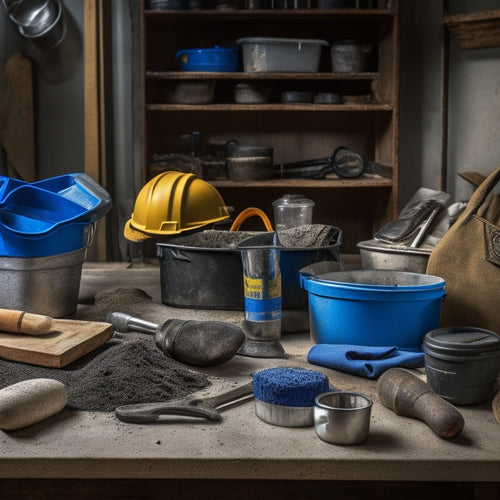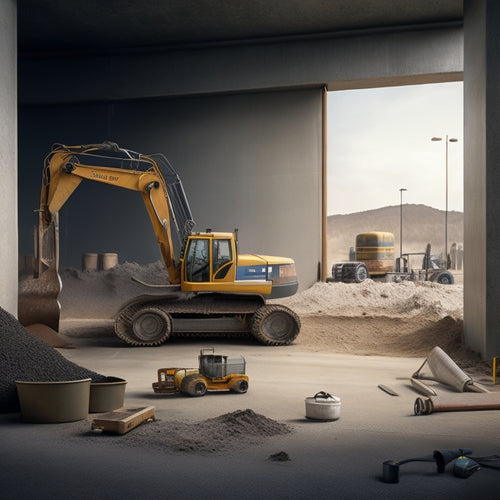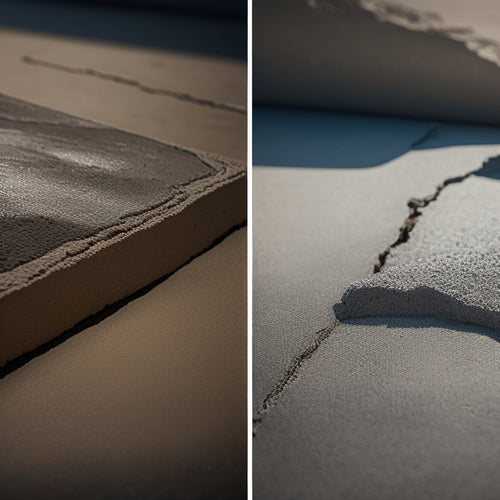
5 Best Tools for Concrete Surface Preparation
Share
When preparing concrete surfaces, you'll need a mix of essential tools to get the job done efficiently. For cleaning, you'll require a selection of degreasers and surface solvents, as well as a pressure washer with the right power source, pressure rating, and flow rate for your project scope. Add in a stiff-bristled brush or broom for heavy-duty cleaning, and don't forget safety gear like respiratory protection, eye safety, and protective clothing. Finally, invest in floor scraping and chiseling tools, like walk-behind scrapers and chiseling hammers, to tackle tough coating removal. You've got the foundation - now, see how each of these tools can be fine-tuned for your specific project needs.
Key Takeaways
• A combination of cleaning agents, degreasers, and surface solvents is essential for effective concrete surface preparation.
• Selecting the right pressure washer, considering power source, pressure rating, and flow rate, is crucial for efficient cleaning.
• Choosing the appropriate brush or broom, based on bristle type, size, and material durability, ensures optimal cleaning results.
• Safety gear, including respiratory protection, eye safety, protective clothing, and foot protection, is vital for preventing injuries and health hazards.
• Floor scraping and chiseling tools, such as walk-behind scrapers, chiseling hammers, and handheld scrapers, are necessary for removing old coatings and preparing the surface.
Essential Cleaning Solution Tools
When preparing a concrete surface, you'll need to remove dirt, grime, and old coatings, and that's where vital cleaning solution tools come into play, helping you to effectively strip and clean the surface.
You'll need to select the right cleaning agents and surface solvents to break down and dissolve the unwanted substances. A degreaser, for instance, is a powerful cleaning agent that can dissolve grease and oil, while a surface solvent can help remove old coatings and adhesives.
It's important to choose the right cleaning solution for the specific type of dirt or coating you're dealing with. You should also consider the surface type, porosity, and environmental factors when selecting your cleaning solution tools.
Pressure Washer Selection Guide
With a clean surface in hand, you'll need a reliable pressure washer to effectively remove dirt, grime, and old coatings, and selecting the right one can make all the difference in achieving a successful concrete surface preparation. You'll want to take into account factors such as power source, pressure rating, and flow rate to guarantee you're getting the job done efficiently.
Here's a breakdown of key considerations:
| Power Source | Pressure Rating (PSI) | Flow Rate (GPM) |
|---|---|---|
| Electric Pressure | 1,500 - 2,000 | 1.5 - 2.5 |
| Gas Pressure | 2,500 - 4,000 | 3.0 - 5.0 |
| Electric Pressure (Light-Duty) | 1,000 - 1,500 | 1.0 - 1.5 |
| Gas Pressure (Heavy-Duty) | 4,000 - 6,000 | 5.0 - 8.0 |
| Combo Kit (Electric & Gas) | 2,000 - 4,000 | 2.0 - 5.0 |
When choosing between electric pressure and gas pressure washers, reflect on the scope of your project and the level of power you require. Electric pressure washers are ideal for smaller, more delicate jobs, while gas pressure washers are better suited for larger, more demanding projects.
Brush and Broom Options
How do you choose the right brush or broom for scrubbing and sweeping concrete surfaces, especially when it comes to tackling stubborn dirt and debris? The key lies in selecting the appropriate bristle type and broom size for your specific task.
For heavy-duty cleaning, stiff-bristled brushes with nylon or polypropylene fibers are ideal for removing thick dirt and grime. Softer bristles, made from natural fibers like corn or coconut, are better suited for more delicate surfaces or for sweeping away dust and dirt.
When it comes to broom sizes, consider the area you need to cover. Larger brooms, typically 18-24 inches wide, are perfect for sweeping large concrete surfaces, such as warehouse floors or parking garages. Smaller brooms, ranging from 12-18 inches, are better suited for tighter spaces, like sidewalks or small rooms.
Additionally, look for brooms with sturdy handles and secure bristle attachments to guarantee efficient and effective cleaning. By choosing the right brush or broom, you'll be well on your way to achieving a clean and prepared concrete surface.
Safety Gear and Protective Equipment
You'll need to gear up with the right safety equipment to protect yourself from the hazards that come with concrete surface preparation. Don't take any chances – the consequences of neglecting safety can be severe.
Start with respiratory protection, as concrete dust can be harmful when inhaled. A dust mask or respirator will help filter out particles, guaranteeing you can breathe easily.
Next, prioritize eye safety. Safety goggles or glasses will shield your eyes from debris and dust, preventing injuries and vision damage.
Don't forget to wear protective clothing, including gloves, long sleeves, and pants, to prevent skin irritation and cuts. Steel-toed boots will protect your feet from heavy objects and equipment. A hard hat is also essential if you're working in an area with overhead hazards.
Floor Scraping and Chiseling Tools
Three essential floor scraping and chiseling tools - floor scrapers, chiseling hammers, and handheld scrapers - will help you efficiently remove old coatings, adhesives, and debris from the concrete surface.
You'll find various floor scraper types, including walk-behind, ride-on, and electric floor scrapers, each suited for specific job sizes and conditions. When choosing a floor scraper, consider the scraper's blade type, width, and adjustment mechanism to guarantee peak performance.
For more aggressive removal, you'll need a chiseling hammer. Mastering chisel techniques, such as using the correct striking angle and applying controlled force, will help you remove thick coatings and epoxy without damaging the concrete.
Handheld scrapers are ideal for smaller areas, tight spaces, and detail work. They're also useful for removing residual material after using a floor scraper or chiseling hammer.
Remember to always operate these tools with caution, wearing necessary safety gear and following the manufacturer's instructions. By selecting the right floor scraping and chiseling tools and honing your skills, you'll be able to achieve a clean, prepared surface for your next concrete project.
Frequently Asked Questions
Can I Use Household Cleaners for Concrete Surface Preparation?
When you're preparing a concrete surface, you might wonder if you can use household cleaners to get the job done.
While they may seem like a convenient option, household cleaners aren't effective for concrete surface preparation. They can leave residue, affect adhesion, and even damage the surface.
Instead, you'll need alternative cleaning solutions specifically designed for concrete, such as degreasers or acid-based cleaners, to guarantee a clean and ready surface.
How Do I Determine the Right PSI for My Pressure Washer?
Imagine a canvas of concrete, awaiting your artistic touch. But, before you release your creativity, you need the right brush - a pressure washer with the perfect psi.
Don't guess, calculate! Consider the surface type, dirt level, and nozzle distance.
For delicate surfaces, opt for electric washers (1000-1500 psi). For tough jobs, gas-powered beasts (2000-4000 psi) are your go-to.
Master the art of surface cleaning techniques, and your concrete canvas will shine.
What Is the Best Way to Remove Oil Stains From Concrete?
When tackling oil stains on concrete, you'll want to act fast to prevent them from setting in.
Start by blotting the stain with a clean cloth or paper towel to remove excess oil.
Then, mix a solution of concrete cleaner and water according to the product's instructions.
Apply the solution to the stain, let it sit for 10-15 minutes, and scrub it with a stiff brush.
Rinse the area thoroughly with clean water, and you'll be left with a stain-free surface.
Can I Prepare a Concrete Surface in Extreme Weather Conditions?
When you're preparing a concrete surface, you're probably wondering if you can get the job done in extreme weather conditions. The answer is, it depends.
If temperatures are extremely high or low, it can affect the surface preparation process. For instance, high temps can cause rapid evaporation, while low temps can slow down the process.
You'll need to adjust your strategy accordingly, taking into account the specific weather conditions you're facing.
How Often Should I Maintain My Concrete Surface Preparation Tools?
You're wise to prioritize tool maintenance to guarantee peak performance.
To maintain your concrete surface preparation tools, you should establish a regular maintenance schedule. Clean your tools after each use, and perform a thorough inspection every week.
Monthly, sharpen or replace worn-out parts, and lubricate moving components.
Conclusion
You've made it to the final step in preparing your concrete surface.
Now, you might be thinking, 'I've invested so much time and effort, what if I still get a subpar finish?'
Don't worry, with the right tools, you'll be on your way to a flawless surface.
By combining essential cleaning solutions, pressure washers, brushes, safety gear, and floor scraping tools, you'll be guaranteed a professional-grade finish that will make your project a success.
Related Posts
-

5 Tools Needed for Quick Fix Concrete Mixing
You'll need five essential tools to tackle a quick fix concrete mixing project efficiently. First, you'll require a s...
-

Why You Need Affordable Concrete Wall Construction Tools
You need affordable concrete wall construction tools to guarantee a profitable project, as the cost of equipment can ...
-

What Tools Ensure Strong Concrete Adhesion at Home
You'll need the right tools to guarantee strong concrete adhesion at home. For surface preparation, use concrete surf...


